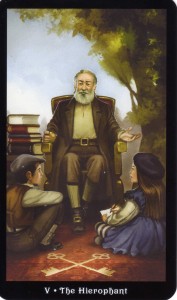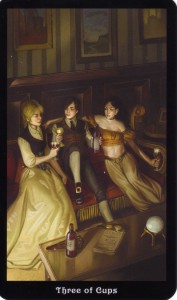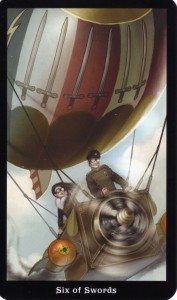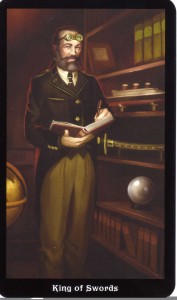The Steampunk Tarot
Posted by: TheReviewer on: April 1, 2012
- In: Deck Reviews | Featured | Latest Decks
- Comment!
~In which The Reviewer waxes lyrical about being British, Doctor Who, The Hitchhikers Guide to the Galaxy, Jules Verne, various RPGs, Abney Park, and – mostly – the Steampunk Tarot by Barbara Moore~
[Public service announcement: the following review should be read in a very posh British accent throughout.]
Part of the beauty of the steampunk genre is the imaginings of an alternative universe based on the foundations of the actual, historical universe we already know, e.g. that of Victorian Britain. This makes steampunk a true friend of the Tarot, as the cards can be used as a tool to make actual our imaginings and desires, to create a more interesting world from the foundations beneath us or behind us.
Tarot, like steampunk, allows us to play creatively with our choices and possibilities, opening our minds and hearts to the new, the exciting, whilst retaining an understanding and appreciation of the large and small cogs and workings of our lives. Steampunk also bears a strong aesthetic principle, with its fashion being its most recognizable feature: aviators, dark wood libraries, cogs and wheels, pistons and machinery, corsetry and bustles, monocles and top hats, tailcoats, lab coats, and a fair amount of tipping the velvet… This highly stylized (stylish!) aesthetic is the key feature of the Steampunk Tarot, filling it with striking visuals and beauty. It is instantly reocognizable, setting itself apart from other decks, and the artwork itself is stunning. It’s the kind of artwork you’d expect to see illustrating hardback editions of Roleplaying Game (RPG) guides, teeming with vibrant characters, activity, and evocative scenery. In fact, anybody familiar with the world of RPGs (as Barbara Moore admits to being in the Introduction of the “Steampunk Tarot Manual†– geeks unite!) will particularly enjoy this deck, with its scenic cards that lend themselves so well to storytelling.
The Steampunk Tarot is deeply symbolic in a non-occult, easy to read, approachable and intuitive manner. Rather than having strange esoteric symbols worked into the image in an awkward fashion like many decks do, the symbolism is in context with the card scene, perfectly natural and cohesive. In fact, many of the cards look just like illustrations of scenes in a larger story, and it would be easy for a reader to tell that story: the story of how, once every year and a day, an aviatrix, researcher and fortune teller all gather in the same bar to rekindle friendships, tell their new stories, make plans for the future and celebrate a bond unique to them (Three of Cups); the story of all the strange, labyrinthine occurrences that lead to the moment in the
Six of Swords, in which a male and female aviator take frantic flight in an airship. Perhaps they have spent years researching, planning and building the perfect airship together, and this is the maiden voyage in which their dreams and knowledge take flight. Or perhaps (as the companion book suggests) the woman is escaping a bad situation, being escorted far and fast away from it by a dashing captain of an airship. (I like to think his name is Cpt. P. Valentine Wilberforce II.) The Two of Cups begs a pre-scene description, with the young man’s eyes focused on his lab research partner as their two magical/energetic essences unite to surprising effect, and the young woman’s lips part as if to exclaim something. Surely what follows is the gentle placement of their cups upon the table and the blossoming of love in a gentle kiss? Or perhaps their union continues as one of platonic friendship, from which the finest scientific research and theory is born?
Interestingly, there are some instances in which traditional Tarot symbolism is referred to, but in a clever way that may not be noticed unless the reader is versed in the Rider Waite Smith tradition: the horse in the Queen of Wands has as part of its barding a black cat’s face, and it wears a sunflower in its hair, for instance. There are also tantalizing recurring symbols to be found, the one that fascinates me most being the Tarot reader/fortune teller/person with one or several Tarot cards. Barbara does not explain the link between the cards that feature this motif, leaving the reader to wonder and discover it for themselves, although the symbol in some of the individual cards is explained in relation to that specific card. Although the deck is firmly rooted in the RWS tradition, keeping the same suit titles, overall card meanings, some of the symbolic content and the numbering of the Major Arcana, it doesn’t just copy the old designs.
Whilst the Steampunk Tarot images are recognizable as the cards they are meant to be, they come alive to an extent that the RWS does not, and it brings something truly unique to the Tarot table. This makes the Steampunk Tarot a stonkingly awesome divination deck, yet it’s definitely not just for fortune telling: this is an immersive and interactive deck, encouraging the reader and/or querent to engage with their question, the possibilities, and their present in order to create the future they desire. The companion manual (I love that the book is called a “Manualâ€â€¦ machines have operating manuals, power tools have operating manuals, of course the Steampunk Tarot is going to have an operating manual!) if filled with wisdom and advice, questions posed to the reader for reflection, and in-depth descrptions of the card themes and meanings in relation to human experience. There’s no heady, over-your-head gumph here, no lecturing and posturing, and this approach in the book gives the Steampunk Tarot a friendly persona. It’s rather like sitting down with a nice cup of tea (and a round of cucumber sandwiches if we’re going to be really Victorian, probably served up by a clockwork butler) with a companion and having a chat.
My favourite spread from the book really highlights the engaging, friendly, explorative nature of the Steampunk Tarot that also puts the (steam)power in the querent’s hands: the Difference Engine spread. It mingles the power of the Tarot with the conscious choice of the querent to give a spread that thoroughly explores all the possibilities that could come from an action, and allows the reader to see the outcome should they choose a certain path. The Difference Engine (named after the theorized machine of Charles Babbage, also later the eponymous machine written about by William Gibson and Bruce Sterling) spread really is something to see and try, but it looks to be a treasure that will serve a reader well for a wide variety of questions.
The steampunk movement has taken off in the past couple of decades, and unfortunately many people think that to make something steampunk you have to just add some cogs and wheels to it, wear a pair of goggles and own a top hat. Corsets are optional, and everything else can be pretty much anything you like the look of. But steampunk is so much more than that: it’s the art of taking something old and not only innovating it, but innovating with it. It’s also a fascination with the way things work, a mind that does not assume, a yearning for adventure and the unusual, and journey ever-onwards to distant, unknown places, people, cultures and discoveries. I was worried that the Steampunk Tarot would just be a traditional Tarot deck with a few added mechanical devices here and there for show, but it really captures the essence of steampunk: the sense of adventure, the world being at your fingertips, and the eagerness to learn and innovate shines through the cards like a beacon. And whilst at first I was a bit disappointed that the suit titles had not been changed to better bit the steampunk theme (say, “Airships†for Swords, “Cogs†for Pentacles, etc.) having seen the deck I am glad of it. To have renamed the suits in such a away would just have been to add a pair of goggles to an outfit or glue some cogs onto a top hat. The innovation is present in the card images themselves, and in the companion manual, the way the cards are described. In fact, I’d say that the Steampunk Tarot not only innovates but also continues the rich steampunk tradition started by the likes of Jules Verne (if you haven’t read his amazing fiction, drop everything you’re doing now and go read it) and H.G.Wells (same rule applies) and adds a marvellous new facet to it (for other contemporary new facets, check out the Victoriana and Clockwork and Chivalry RPGs, the annual Waltz on the Wye, and the addictive music of Abney Park.) Steampunk is becoming big, so for once it’s nice to see the Tarot keeping up with the times.
Barbara Moore does a brilliant job of making the cards “real†for the reader, with the use of a very small bit of flavour text prefacing each card description, usually written in the first person as the main character of that card. These flavour texts made me think, made me laugh out loud, and on a couple of occasions made me run around my house excitedly shouting to my housemate. Firstly, you can hear the English accent dripping from them (“It’s bloody hard work keeping this thing going†– XV The Devil), and there’s something quintessentially British about statements such as “No, I don’t want any tea. Can’t you see I’m busy?†(Four of Cups) and “The misuse of tools can lead to a mickle mess.†(Three of Swords.) Any author using the term “mickleâ€, and mentioning tea, gets bonus points from me. As does an author who references one of the great modern English writers Douglas Adams (“The long, dark teatime of the soul isn’t nearly as romantic as one imagines.†- Nine of Swords) and one of the great Elizabethan English writers (“Juliet was a poser†– Page of Cups). There are even flavour texts that inspired thought processes that perhaps only a British reader would think of, which probably weren’t intentional, yet still apt, such as the Queen of Wands using a French term most recently made popular by David Tennant’s Doctor in the distinctly British TV series “Doctor Who.†(“Allons-Y!â€)  The book also has “Tarot Readings Tips†scattered throughout at the end of card descriptions, adding new layers to the cards and bringing the descriptions down to earth in a reading format.
Add such interesting text to such evocative card images, and you’ve got an amazing Tarot deck that is easy to use, accessible, intuitive, beautiful and fun. Interestingly, this also means that perhaps the Minor Arcana are the deck’s strongest point, an odd occurrence in a Tarot deck, since the Major Arcana are, as implied by their name, the “Bigger†secrets. Here, the Majors are still excellent and very readable, but they are filled with more abstract concepts and cosmic images as opposed to the Minor Arcana, which are filled with activities of everyday life that are instantly recognizable. The Court Cards are a little more challenging to read, but this is the case with nearly every deck because of the nature of the Courts! However, the Steampunk’s Courts still offer some interesting and easy to read scenes, particularly in the Kings and Queens (I have a bit of a crush on the King of Swords…)
The Steampunk Tarot is the standard size of a Llewellyn Tarot deck, which is a plus, but comes packaged with the standard, ubiquitous plain white box that seems to serve only as filler to keep the deck from being bashed around in the box in transit, and is of no use to anybody otherwise. (Some Llewellyn decks have included an organza bag, such as the Llewellyn Tarot by Anna-Marie Ferguson – I would happily pay a little more for a deck if it came with a bag, rather than the horrible plain box!) The card backs are wonderful, but non-reversible, showing an illustration of all four suit symbols in steampunk style, embedded in a clockwork machine of some kind. The companion manual is a great read, brilliant for beginners and inspiring for experienced readers.
The Steampunk Tarot is set to become a well-loved addition to both the Tarot world and the steampunk movement. It’s a great deck for beginners, whilst also thoroughly immersing itself and the reader in its very distinctive theme – a hard balance to strike. It also brings out a bit of my British patriotism, being a reminder of the rich tradition from which steampunk stems, something no Tarot deck has yet managed to do, and inspires the storyteller in me to approach the Tarot even more from the angle of joint storytelling (RPGs again…!) It gives me a geekgasm (the illustrator, Aly Fell, was an animator for the British childrens’ TV shows Dangermouse and Count Duckula, which basically means this guy helped raise me.) It’s a bloody brilliant, bloomin’ marvellous, stonkingly awesome deck for anybody to own and use. Jolly good show, Barbara and Aly!
The Steampunk Tarot, by Barbara Moore & Aly Fell
Llewellyn Publications, 2012
ISBN-10: 0738726389
ISBN-13: 978-0738726380
Search
- Veronique Coppin: could you please send me the link to download the companion book with extra information on the gilded reverie lenormand cards? It's no longer availab
- Conversation with Karen Lisa Salamon – Eng Agger · MA Fine Art Digital: […] card which he used to start his imagination. Dali read the cards; he saw signs. It is to find in “Tarot Universal Dali”. Seeing
- Deck Overview: The Steampunk Tarot – Deanna Discusses: […] Blog reviews: Aeclectic Tarot, New Paths Tarot, Perspectives on Tarot, Tarot Elements, and The Tarot Review […]
Categories
- Announcements (3)
- Book Reviews (1)
- Deck Reviews (18)
- Featured (22)
- Golden Oldies (3)
- Latest Decks (10)
- Sneak Peaks (6)
Get a free blog at WordPress.com
Albeo theme by Design Disease




